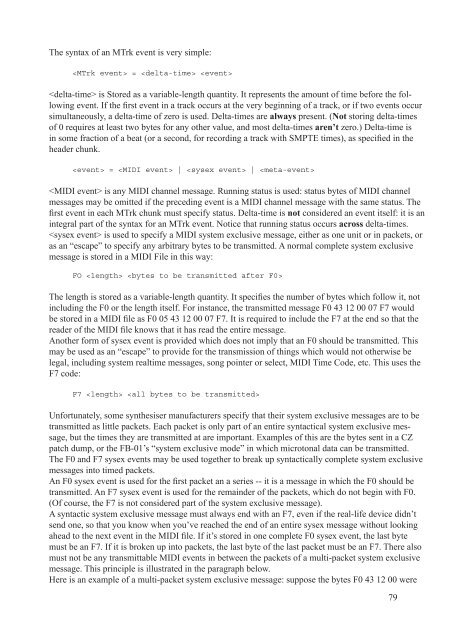2.3 Relaxatie-oscillator
2.3 Relaxatie-oscillator
2.3 Relaxatie-oscillator
You also want an ePaper? Increase the reach of your titles
YUMPU automatically turns print PDFs into web optimized ePapers that Google loves.
The syntax of an MTrk event is very simple:<br />
= <br />
is Stored as a variable-length quantity. It represents the amount of time before the following<br />
event. If the first event in a track occurs at the very beginning of a track, or if two events occur<br />
simultaneously, a delta-time of zero is used. Delta-times are always present. (Not storing delta-times<br />
of 0 requires at least two bytes for any other value, and most delta-times aren’t zero.) Delta-time is<br />
in some fraction of a beat (or a second, for recording a track with SMPTE times), as specified in the<br />
header chunk.<br />
= | | <br />
is any MIDI channel message. Running status is used: status bytes of MIDI channel<br />
messages may be omitted if the preceding event is a MIDI channel message with the same status. The<br />
first event in each MTrk chunk must specify status. Delta-time is not considered an event itself: it is an<br />
integral part of the syntax for an MTrk event. Notice that running status occurs across delta-times.<br />
is used to specify a MIDI system exclusive message, either as one unit or in packets, or<br />
as an “escape” to specify any arbitrary bytes to be transmitted. A normal complete system exclusive<br />
message is stored in a MIDI File in this way:<br />
FO <br />
The length is stored as a variable-length quantity. It specifies the number of bytes which follow it, not<br />
including the F0 or the length itself. For instance, the transmitted message F0 43 12 00 07 F7 would<br />
be stored in a MIDI file as F0 05 43 12 00 07 F7. It is required to include the F7 at the end so that the<br />
reader of the MIDI file knows that it has read the entire message.<br />
Another form of sysex event is provided which does not imply that an F0 should be transmitted. This<br />
may be used as an “escape” to provide for the transmission of things which would not otherwise be<br />
legal, including system realtime messages, song pointer or select, MIDI Time Code, etc. This uses the<br />
F7 code:<br />
F7 <br />
Unfortunately, some synthesiser manufacturers specify that their system exclusive messages are to be<br />
transmitted as little packets. Each packet is only part of an entire syntactical system exclusive message,<br />
but the times they are transmitted at are important. Examples of this are the bytes sent in a CZ<br />
patch dump, or the FB-01’s “system exclusive mode” in which microtonal data can be transmitted.<br />
The F0 and F7 sysex events may be used together to break up syntactically complete system exclusive<br />
messages into timed packets.<br />
An F0 sysex event is used for the first packet an a series -- it is a message in which the F0 should be<br />
transmitted. An F7 sysex event is used for the remainder of the packets, which do not begin with F0.<br />
(Of course, the F7 is not considered part of the system exclusive message).<br />
A syntactic system exclusive message must always end with an F7, even if the real-life device didn’t<br />
send one, so that you know when you’ve reached the end of an entire sysex message without looking<br />
ahead to the next event in the MIDI file. If it’s stored in one complete F0 sysex event, the last byte<br />
must be an F7. If it is broken up into packets, the last byte of the last packet must be an F7. There also<br />
must not be any transmittable MIDI events in between the packets of a multi-packet system exclusive<br />
message. This principle is illustrated in the paragraph below.<br />
Here is an example of a multi-packet system exclusive message: suppose the bytes F0 43 12 00 were<br />
79


